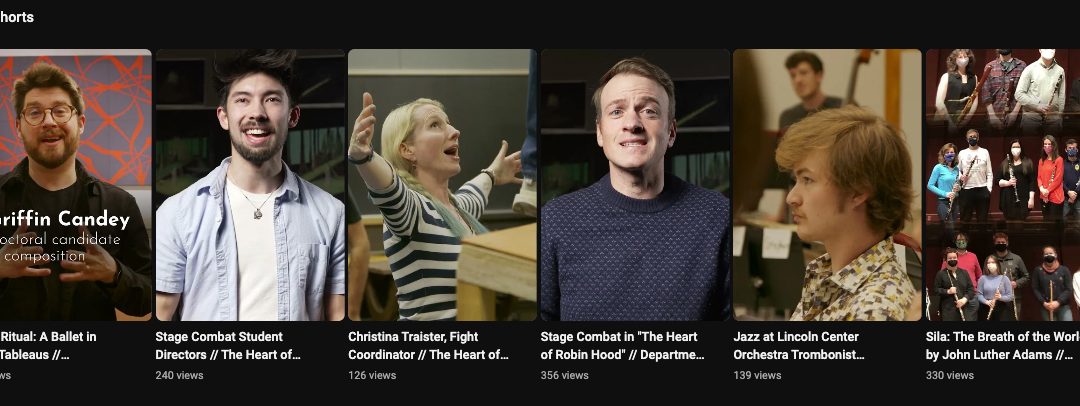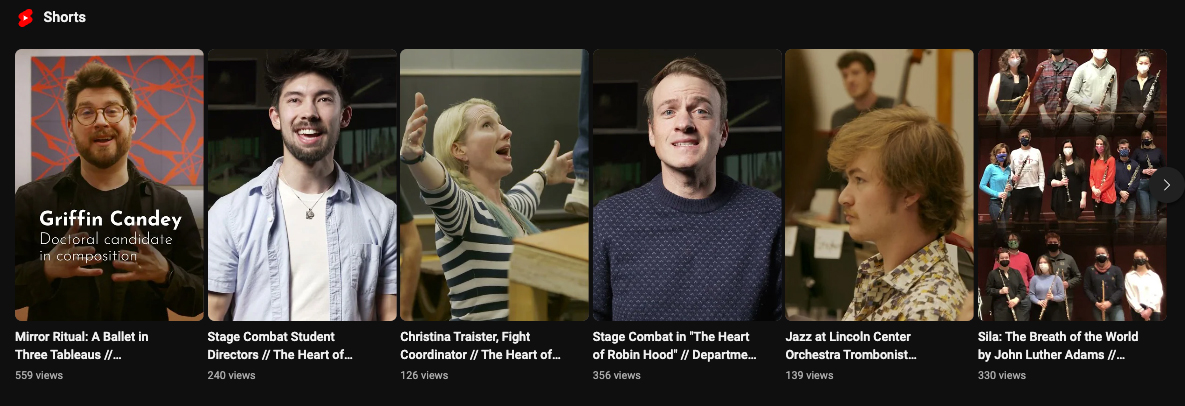Michigan Muse Winter 2023 > Digital Transformation
Digital Transformation: SMTD Embraces Advanced Multimedia Technologies, Benefiting Students, Faculty, and Audiences
By Claudia Capos
The COVID-19 pandemic ushered in technological advances at SMTD that forever recast its performance and pedagogical landscape. The abrupt closure of classrooms, recital halls, and concert venues in March 2020, followed by two years of pandemic restrictions on live audiences, catapulted SMTD into a new era, with performing arts productions now routinely recorded on video and published on YouTube or livestreamed online to remote viewers worldwide.
This seismic shift took the coordinated efforts of SMTD’s video production and IT staff members, faculty, students, and tech-savvy alumni to ramp up the school’s digital capabilities and satisfy the demand for video and livestreaming. This hard-won digital transformation has played out well at SMTD, enabling the school to showcase student and faculty talent and reach broader audiences. It also has strengthened connections with patrons and prospective students and better positioned SMTD graduates for successful careers.
Few people, however, know the high-tech drama that took place behind the scenes during the early days of the pandemic.
Navigating a Steep Learning Curve
SMTD video producer Chris Boyes has never forgotten March 15, 2020, the day when performance stages around campus went dark, faculty and staff vacated their offices, and students retreated to their dorm rooms and apartments to wait out the COVID lockdown.
Suddenly, he found himself in a very different position. “Before COVID, nearly everything the SMTD marketing department produced was something I filmed and edited,” Boyes recounted. “During the pandemic, when everyone had to isolate, it was a lot different. Faculty and students had to start producing their own video content because I couldn’t meet them in person to do the filming.”
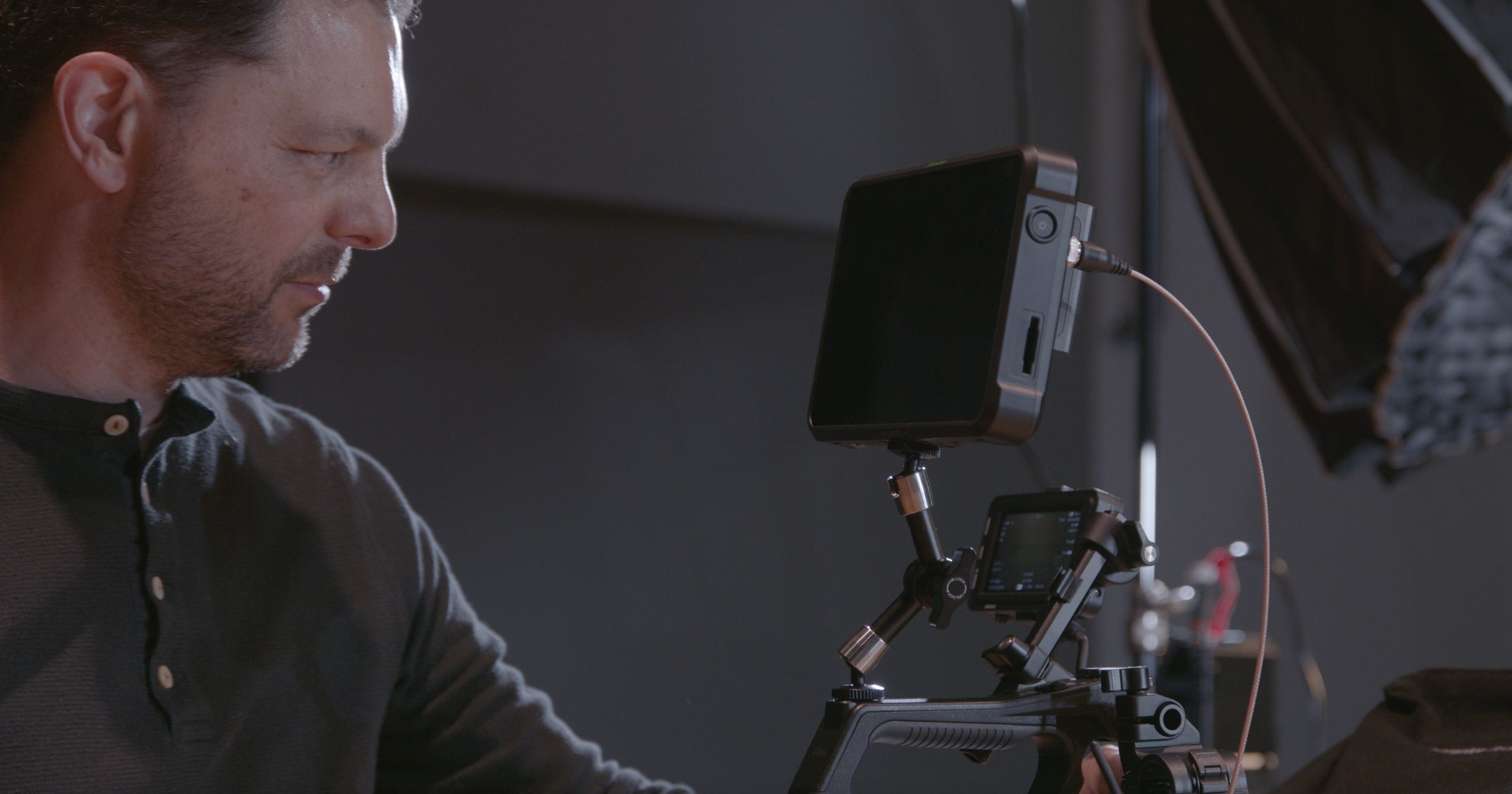
Chris Boyes, SMTD video and multimedia manager.
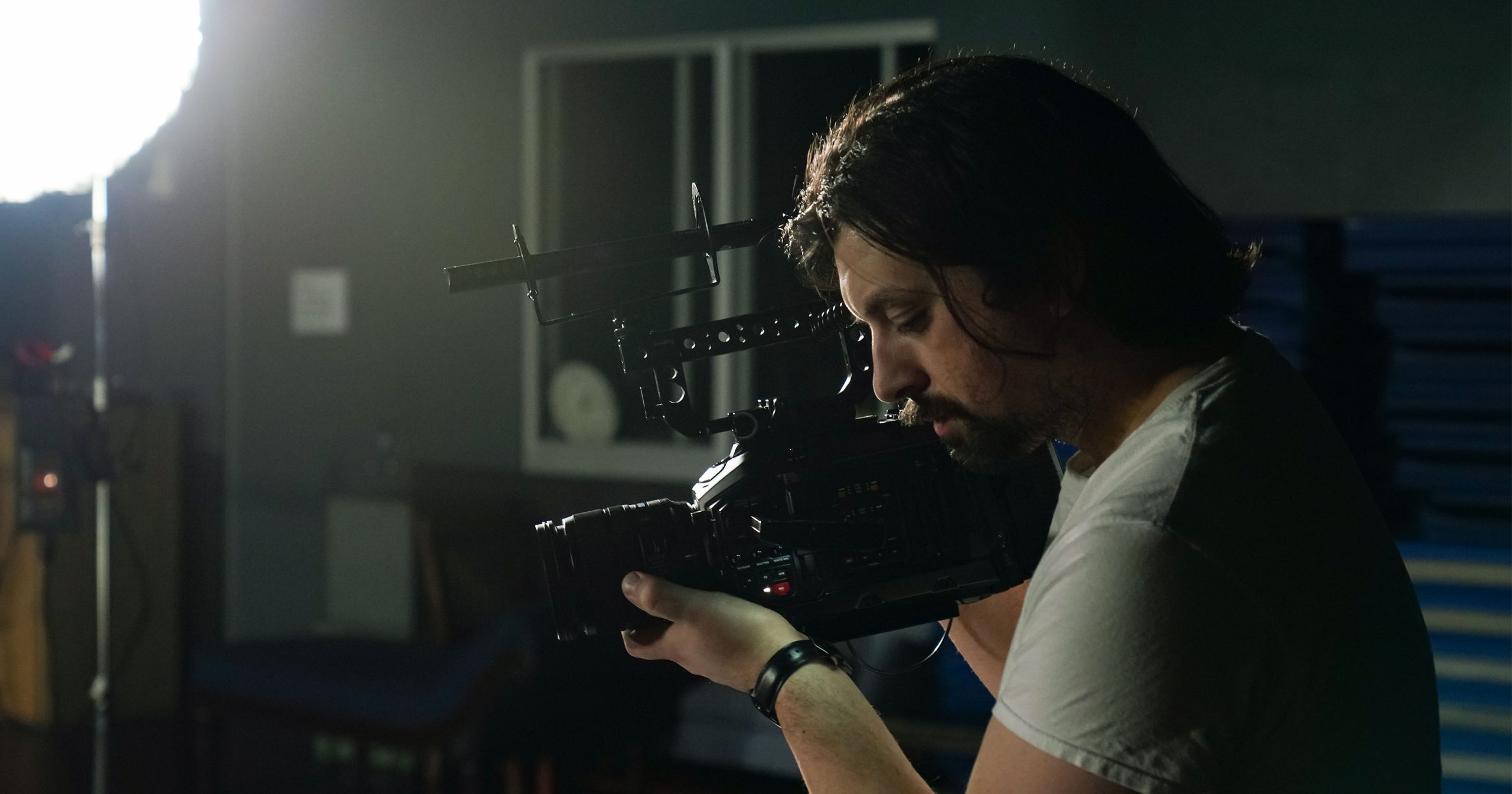
Mathew Pimental, SMTD video and multimedia coordinator.
Navigating the steep learning curve took time and patience. “My technical expertise was refocused on helping other people use various tools to create video content that I could then edit, brand, and post on SMTD’s YouTube channel,” Boyes recalled.
To complicate matters, the 2020 commencement ceremony in April was canceled. Boyes and the marketing team took on the daunting task of designing and producing the school’s first-ever virtual commencement program, which included embedded videos, in just over a month and a half.
A similar transformation took place on the SMTD team that handles much of the livestreaming of performances. The IT department had begun experimenting with livestreaming in 2015. Equipment was installed in a few venues; in some venues, that equipment could be operated by the performers, enabling students and faculty to stream performances for those who couldn’t attend in person.
During the pandemic, the demand for livestreaming increased dramatically. “The pandemic helped jump-start what we wanted to do before,” noted Greg Laman, director of technology. SMTD invested in equipment and staff, shifting the duties of Alvin Hill (MA ’09, media arts), an artist and lecturer in the performing arts technology department, to manage a team of students who quickly became proficient at livestreaming.
Tapping Alumni Tech Talent
With COVID restrictions still in place in September 2020, requests for video recording and livestreaming of performances poured in from orchestral, vocal, theatrical, and musical theatre groups.
Lacking the equipment and personnel to meet the surging demand, SMTD tapped the tech talent of alumni who own and operate their own multimedia production companies. Two of those firms – Dave Schall Acoustic and Sly Pup Productions – were among those who stepped up to the plate to help out. “They definitely helped SMTD marketing and the events team, as well as individual students, faculty, and departments,” Boyes said. “It was a collaborative effort to expand the school’s video capabilities and to produce new content.”
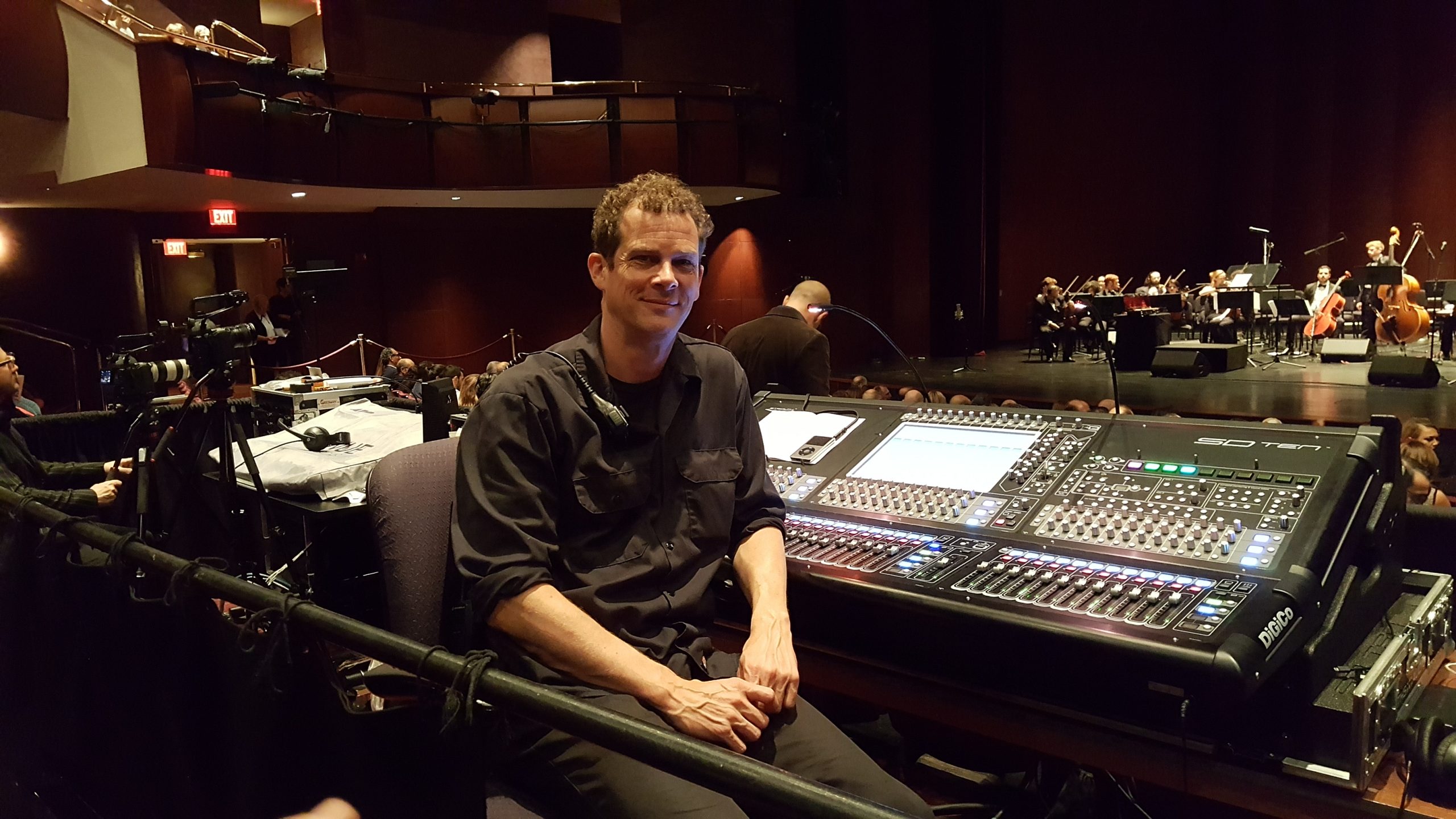
SMTD alum Dave Schall, owner of Dave Schall Acoustic.
Dave Schall, MM ’98 (bassoon), who launched his recording-services company in 1997, already had established a solid track record in Metro Detroit and internationally. He had been doing final-cut mixed-media production and livestreaming at SMTD for over a decade. “Livestreaming was just an after-thought before COVID,” Schall said. “But after the pandemic struck, it became a necessity.”
In early fall, Eugene Rogers, associate professor of music and director of university choirs, asked Schall for help in livestreaming the annual Grand Night for Singing concert, which was scheduled for late October.
Rogers realized the importance of showcasing SMTD’s vocal talent and preserving the cohesiveness of the choral community during the pandemic. Presenting the concert virtually via livestreaming would enable friends and family to watch musical theatre, choral music, and solo voice performances in real time on SMTD’s Facebook and YouTube channels.
Schall worked his magic, and the show debuted virtually for the first time. “We ended up at peak density and had 384 individual videos on the screen at the same time,” he recalls.
Much of Schall’s video production work has been devoted to recording and editing performances by the school’s large band and orchestra ensembles. Schall says his classical music training has proven invaluable in his production business. “My background as a performer has given me a big boost in terms of knowing what composers, conductors, and musicians need when I am choosing video angles and editing or cutting the footage,” he explained. “Being able to identify various instruments, read a score, understand musical phrasing, and interpret conductors’ gestures enables me to enhance the performance and highlight what needs to be shown in any given moment.”
Watch a playlist of videos produced for SMTD by Dave Schall Acoustic, including the 2020 Grand Night for Singing, an excerpt from a University Symphony Orchestra concert, a Symphony Band concert, and more.
Speaking the Language
David Newton, BM ’16 (percussion); Jameson Eisele, BFA ’15 (performing arts technology); and Patterson McKinney, BM ’15, MM ’17 (percussion), launched Sly Pup Productions in 2016. A few years later, the COVID pandemic would turbocharge their video production business.
“Initially we started working with students who wanted recital videos, and then SMTD hired us to record concerts,” said Eisele and Newton, the company’s two remaining co-founders. “When the COVID pandemic hit, we were in the right place at the right time. We had an amazing year because we were available, and everyone needed digital media to continue making art during the lockdown. We were very lucky.”
In September 2020, University Productions – the producing organization behind SMTD’s fully staged productions – brought Sly Pup on board as its video team to handle the recording and production of its large-stage operatic, theatrical, and musical theatre performances for viewing by a digital audience. Fitting together all the pieces of the production puzzle was quite a challenge.
“We did everything from start to finish,” said Newton and Eisele. “We held pre-production meetings with the students, faculty, set designers, lighting technicians, and audio team. Then we did the filming, editing, audio mixing, color correction, and captioning. We delivered the finished videos and uploaded them to YouTube for digital premieres that could be viewed remotely at a scheduled day and time.”
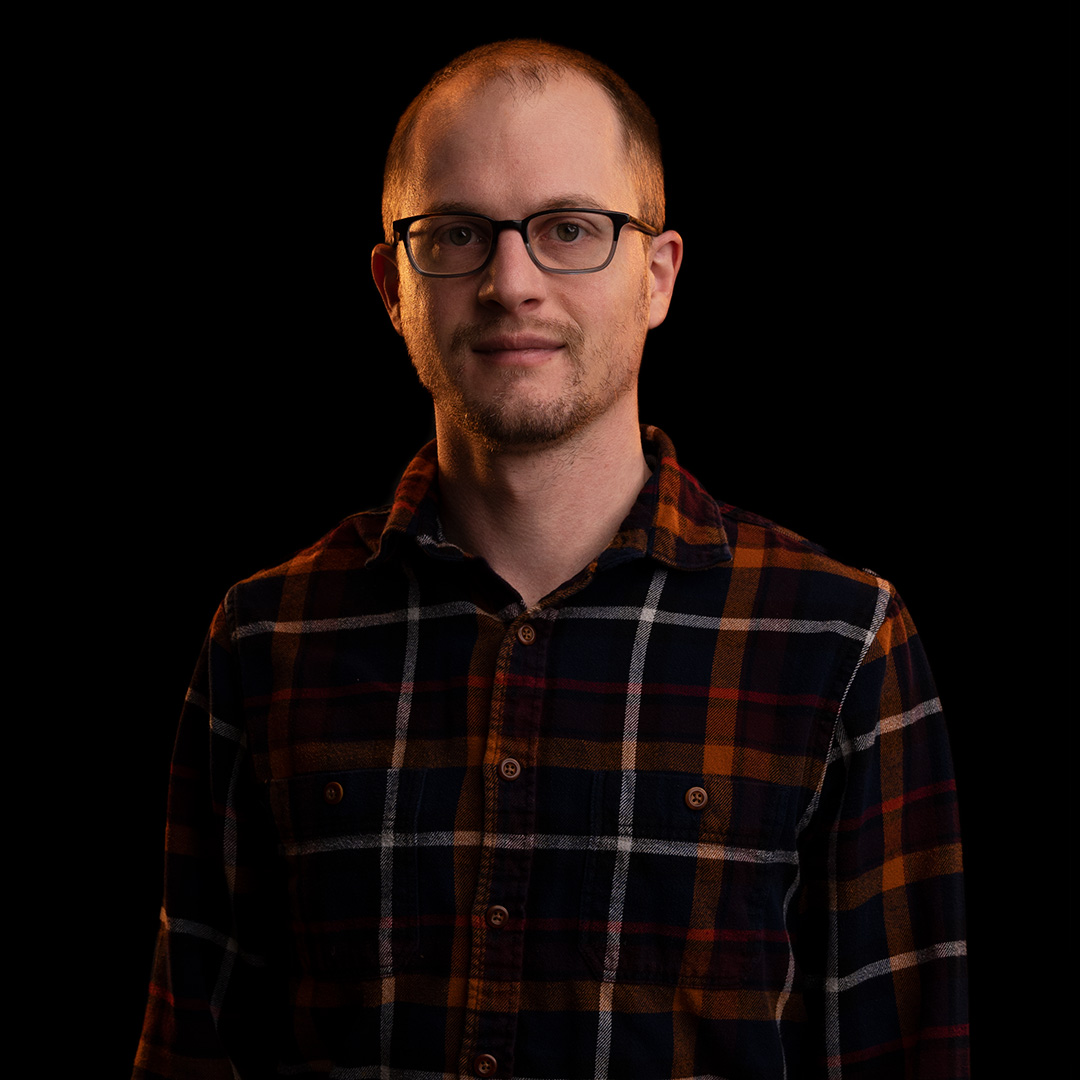
David Newton, co-founder of Sly Pup Productions, earned a BM in percussion from SMTD in 2016.
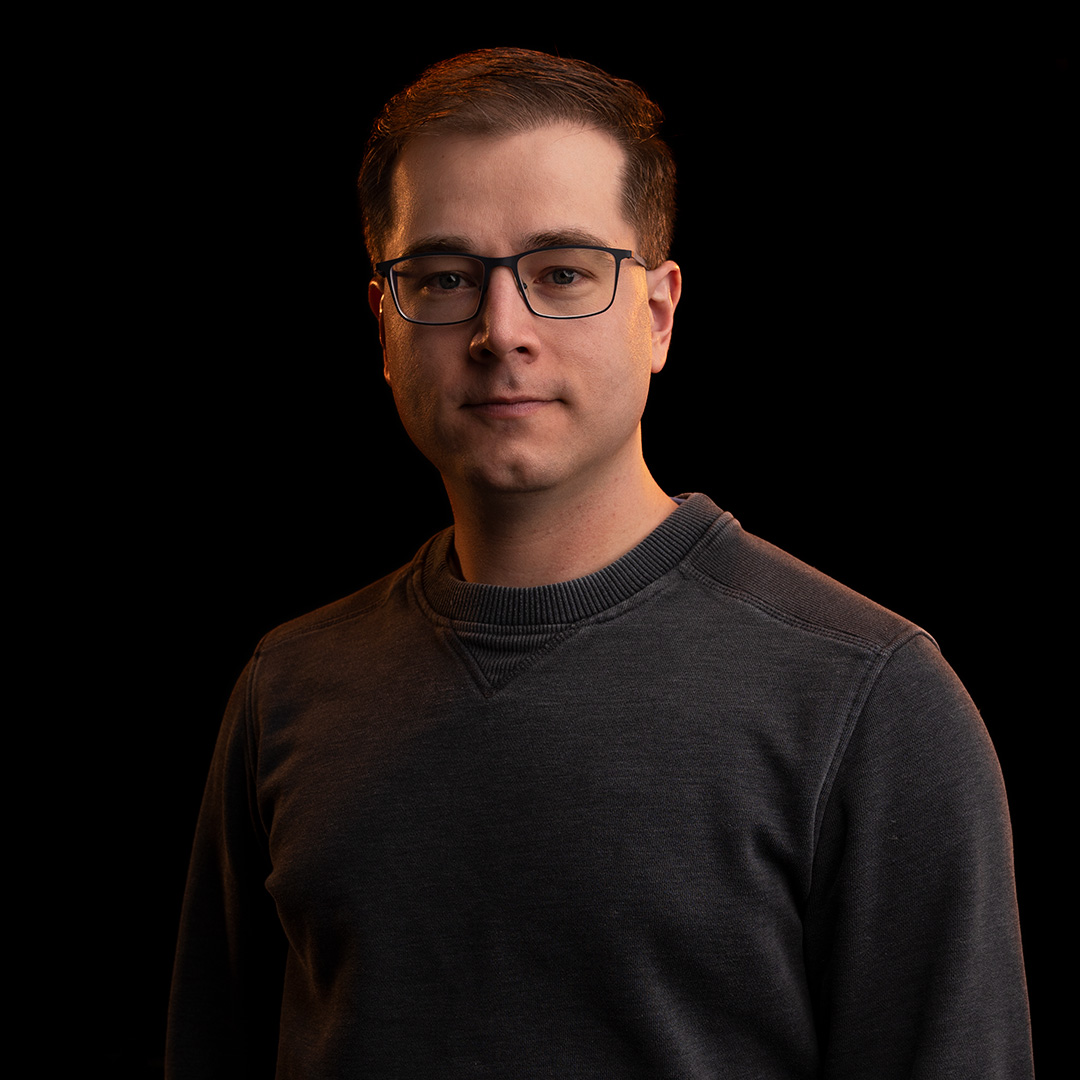
Jameson Eisele, co-founder of Sly Pup Productions, graduated from SMTD with a BFA in performing arts technology in 2015.
In addition, Sly Pup began livestreaming concerts performed by the Department of Chamber Music, which broadened the audience and increased the visibility of the performers.
Eisele says his U-M degree in performing arts technology and his musical experience as a mellophone player in the Michigan Marching Band laid the foundation for his technical role at Sly Pup. “Being able to study performing arts technology at U-M within SMTD was an advantage for me,” Eisele remarks. “In our production work, I’ve found that musicians use a very specific vernacular, so it is important to be able to speak their language.”
Newton, who performed in four SMTD bands and orchestras, has applied his music background to editing video footage at the company. “It’s all about rhythm and using it in the editing process,” Newton says. “If you can hide the edits inside the music, it doesn’t distract the audience from the overall performance.”
The return of live audiences to performance venues has not diminished the demand for videos and livestreaming, according to the Sly Pup co-founders. “People still like going to concerts,” they say. “But there’s a growing awareness of the importance of reaching remote audiences via multimedia video that resides on the Internet for people to enjoy.”
This playlist of videos produced for SMTD by Sly Pup Productions includes Godspell, Don Pasquale, the spring 2022 concert Music from Auschwitz, and more.
Bolstering Digital Capabilities
The resilience and creativity of SMTD, and the university community in general, have accelerated digital advances, yielding many benefits.
SMTD has purchased new video and livestreaming equipment, the events team has grown, and the marketing team has hired a second video producer, Mathew Pimental, to bolster the school’s internal digital capabilities.
“While we invested heavily in streaming to meet needs during the height of the pandemic, we have continued to see a great deal of interest in streaming performances from SMTD faculty and students and from those who want to tune in to performances from home,” said Eli Salembier, director of finance and operations.
“In the 2021–22 academic year, we streamed 170 performances, logging over 10,000 views,” he added. “It has been an investment in technology that is returning dividends by allowing us to connect with more patrons, student families, donors, and prospective students.”
“We have momentum now,” said Laman. “We’re continuing to do more and continuing to improve.” One recent improvement involved new hardware designed not just to improve the quality of livestreaming, but to make the setup and teardown of equipment more efficient, enabling the events team to say yes to more livestreaming requests.
Boyes reports the number of videos published and viewed on the SMTD YouTube channel has skyrocketed since the COVID pandemic began, achieving a nearly 150% increase in daily video views between the early days of SMTD’s channel in 2015 and the end of 2022. The school’s YouTube subscriber base also has risen from near zero in 2015 to more than 6,000 today.
Recently, Boyes and Pimental have increased production of 60-second Instagram reels (which display vertically rather than horizontally) and YouTube shorts. “People are watching more video content on their mobile devices, so video production has followed that trend,” Boyes said.
Reaching Worldwide Audiences
The dramatic increase in the use of video production, livestreaming, and novel technologies has altered the DNA of the performing arts over the past three years. “As a result of the pandemic, we have incorporated video and Zoom technology into many of our preparatory and rehearsal activities for our productions,” said Jeffrey Kuras, director of University Productions and adjunct assistant professor of theatre. “These technologies have increased communication among the creative and production staffs.”
For example, in preparing for the production of Rent for spring 2023, the Department of Musical Theatre has asked its students to make video submissions for the first round of auditions for its winter-term productions, given that both the director and choreographer of Rent are working remotely. Having the audition materials on video allows them to take more time in their consideration of casting, according to Kuras.
In addition, he noted, “We now routinely make videos of rehearsals, so the designers and production staff can better meet the needs of the actors in the rehearsal room.” The department also conducts its periodic production meetings over Zoom, enabling out-of-town guests to take part in planning the physical aspects of a production, including scenery, props, costuming, lighting, sound, and orchestra.
Matt Albert, associate professor of music and chair of the Department of Chamber Music, says the partnership with Sly Pup Productions, which began in fall 2020, has enabled the department to offer multi-camera livestreams and recordings of every student chamber music concert on campus.
“The livestreams are dynamic, with the shifting camera angles and high-quality audio giving audiences at home a sense of being there in the room,” Albert said.
“Our audiences have expanded from student, staff, faculty colleagues, and our local supporters to families and friends of the performers all across the world,” he continued. “And the recordings themselves have been useful for students in applying to graduate schools, competitions, and funding opportunities.”
Director of Bands Michael Haithcock embraced digital technology early in his career at SMTD. “When I came to the school in 2001, I decided to record CDs as a way of archiving collaborations with U-M composers and my faculty colleagues as soloists,” recalled Haithcock, Arthur F. Thurnau Professor of Music. “I wanted to create a ‘time capsule’ type of archive and determined this type of digital touring was a more cost effective and efficient use of students’ time than the traditional forms of touring.”
“In 2016, we began to use Dave Schall to capture audio and video of every Symphony Band concert, with the product posted on the Symphony Band’s dedicated YouTube channel,” Haithcock remarked. “The response to the channel has been a huge aspect in recruiting and a service to the composers. The channel has been widely embraced by student performers, their families, and a wide variety of constituents.”
The addition of livestreaming as a result of the pandemic has offered yet another way for audiences to hear and appreciate the Symphony Band and hundreds of other student performers. As Haithcock noted, “Streaming has been the icing on the cake.”
Check out the SMTD YouTube channel for hundreds of videos and shorts created by SMTD staff and others.
The [Copy] Right Stuff: Sorting Out Complicated Licensing Laws for Video Recording and Livestreaming
Alizabeth Nowland’s leading role is vital, yet invisible: she oversees all the music preparation for more than 50 ensembles affiliated with SMTD.
As the performance librarian and licensing manager, Nowland works tirelessly behind the scenes with these ensembles to procure music and text for their performances and to ensure they are in compliance with copyright licensing laws.
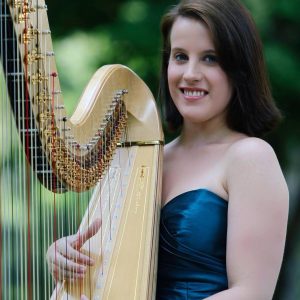
“It’s a very busy, comprehensive job, but one I enjoy,” Nowland said. “I come from a family of attorneys, so it helps to have that in my blood.”
Her job got a lot more complicated during the COVID pandemic when in-person concerts, recitals, and theatrical productions were canceled, and students, faculty, and groups began posting videos of their performances or livestreaming events in real time for remote viewing.
This new paradigm has required additional licenses and permissions from copyright holders and music distributors, which Nowland must negotiate.
Livestreaming Licenses
Previously, U-M negotiated long-term public performance licenses with ASCAP and BMI, allowing music in the repertoire controlled by these two performance rights organizations (PROs) to be performed publicly on campus or in university-owned or -leased venues. All performances had to be part of an educational program or activity.
These so-called “small rights” agreements (which only apply to the non-dramatic performance of copyrighted songs) were very comprehensive and covered the entire university for a great deal of music, according to Nowland. However, the licensing permissions were limited to in-person live musical performances, such as concerts and cabarets. Livestreaming and published videos were not included in these agreements.
As a result of these restrictions, a livestreaming license is often (but not always) needed to create an audio/visual feed of a musical performance for hosting on the university website, usually with access through an SMTD link. Livestreaming on social media platforms such as YouTube or Facebook must be disclosed in advance to the copyright holder or music distributor.
“For a livestreaming license, the feed has to be live capture,” Nowland explained. “It cannot be recorded and posted later, because that does not qualify as a true livestream. For a piece of music that is rented, the copyright holder often requires that the livestream cannot be behind a paywall. In other words, it must be accessible free at no charge to the public.”
Music Synchronization Licenses
Since COVID, many SMTD bands, orchestras, and choral ensembles have elected to make audio/video recordings of their performances that can be posted on one of SMTD’s YouTube channels. This requires a music synchronization license for every copyrighted song that will be performed.
These “sync” rights are granted by the copyright holder of a song and allow the music user to synchronize the music with some kind of visual media output. “Regardless of whether we are posting the song on YouTube or using it for an archival recording,” Nowland said, “we have to pay for a synchronization license to sync the audio with the visual component.”
Procuring Grand Rights
When a copyrighted song is used in the public performance of a dramatic work, such as a stage play, opera or operetta, musical theatre production, or dance recital, a “grand rights” license (aka theatrical license) must be obtained directly from the copyright holder. (PROs such as ASCAP and BMI only handle the public performance rights for musical compositions used in non-dramatic performances, such as concerts.)
“The scope of dramatic performances is much bigger than it is for musical events, so often the cost for grand rights is significantly greater than the cost for small rights,” Nowland explained.
During the COVID lockdown, SMTD theatrical and dance ensembles also began posting recorded video productions online, requiring synchronization licenses for each and every song under copyright. Negotiating all those contracts for sync rights was no mean feat, according to Nowland.
She also was responsible for obtaining livestreaming licenses in cases where real-time feeds of dramatic performances were streamed on the university website.
The New Normal
Although SMTD has returned to in-person live performances, the requests for synchronization licenses have not decreased. The new normal is here to stay.
“I’ve procured hundreds of sync licenses since the pandemic began, and that number is remaining at a consistently high level,” Nowland reported. “Livestreaming also is ramping up, and the quality of postings is improving.” These new technologies are expanding the reach and increasing the visibility of SMTD students and faculty. “We’re always trying to improve the online content for our audiences to showcase the talent and accomplishments of our students and faculty,” she said. “Anytime I can be involved in that process, it is so rewarding.”

